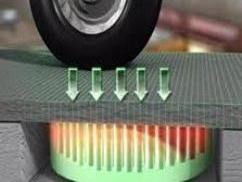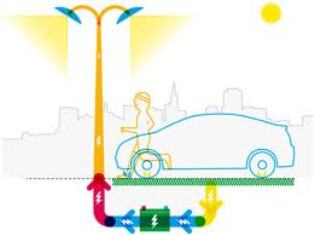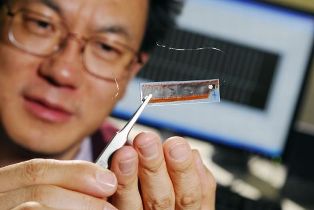Categories: Featured Articles » Interesting electrical news
Number of views: 73139
Comments on the article: 18
Piezogenerators are new sources of electricity. Fantasy or reality?
 A thin piezoelectric film on a window pane that absorbs street noise and converts it into energy to charge the phone. Pedestrians on sidewalks, metro escalators that charge autonomous lighting batteries through piezo transducers. Dense streams of cars on busy roads, generating megawatts of electricity, which is enough for entire cities and towns.
A thin piezoelectric film on a window pane that absorbs street noise and converts it into energy to charge the phone. Pedestrians on sidewalks, metro escalators that charge autonomous lighting batteries through piezo transducers. Dense streams of cars on busy roads, generating megawatts of electricity, which is enough for entire cities and towns.
Fantasy? Unfortunately, yes so far, and this may remain. There is a high probability that the excitement around sensational messages about wonderful prospects will soon end piezoelectric energy generators. And we will again dream of safe, renewable and, to be honest, cheap electric energy received with the involvement of other phenomena. After all, the list of physical effects is remarkably long.
The phenomenon of piezoelectricity was discovered by the brothers Jackson and Pierre Curie in 1880 and has since become widespread in radio engineering and measurement technology. It consists in the fact that the force applied to the sample of a piezoelectric material leads to the appearance of a potential difference on the electrodes. The effect is reversible, i.e. the opposite phenomenon is also observed: by applying voltage to the electrodes, the sample is deformed.
Depending on the direction of energy conversion piezoelectrics are divided into generators (direct conversion) and motors (inverse). The term “piezoelectric generators” does not characterize the conversion efficiency, but only the direction of energy conversion.
Exactly the first phenomenon associated with the generation of electricity under mechanical stressIn recent years, engineers and inventors have become interested. As from a cornucopia, there were reports of the possibility of obtaining electric energy, utilizing street noise, the movement of waves and wind, and the loads from the movement of people and cars.
Today, several examples of the practical use of such energy are known. At the Marunuchi Metro Station in Tokyo, piezoelectric generators are installed in the ticket room. The accumulation of passengers is enough to control turnstiles.
In London, in an elite disco, piezoelectric generators feed several lamps that stimulate dancing and ... the sale of soft drinks. Piezoelectric lighters have become commonplace. Now any smoker carries his own "power station" in his pocket.
Relatively recently, a message has been blown up by the world public about testing systems for generating energy from moving vehicles. Israeli scientists from a small firm Innowattech calculated that 1 kilometer of the autobahn can generate electric power up to 5 MW. They not only performed the calculations, but also uncovered several tens of meters of the highway and mounted their piezoelectric generators under it. It seemed that finally a breakthrough had come in the field of alternative energy. But this raises serious doubts.
Let us consider in more detail the physics of processes occurring in piezoelectric. To get acquainted with the principles of energy generation by piezoelectric materials, an understanding of several basic mechanisms is sufficient. During mechanical action on the piezoelectric element, atoms are displaced in the asymmetric crystal lattice of the material. This displacement leads to the appearance of an electric field, which induces (induces) charges on the electrodes of the piezoelectric element.
Unlike a conventional capacitor, the plates of which can save charges for a long time, the induced charges of the piezoelectric element are retained only as long as the mechanical load acts. It is at this time that energy can be obtained from the element. After removal of the load, the induced charges disappear. In fact, the piezoelectric element is an insignificant current source with a very high internal resistance.
Since the specialists of Innowattech did not consider it necessary to share the results of their experiment with the general public, we will try to make rough numerical estimates of the effectiveness of the work of piezoelectrics as energy source. As an object for calculations, we take an ordinary household piezo-lighter - the only product that is now widely used.
From the abundance of technical characteristics of piezoelectric materials, we need only a few. This is the value of the piezoelectric module, which for common (and others do not yet produce others) piezoelectrics ranges from 200 to 500 picocoulons (10 to minus 12 degrees) per newton, and characterizes the efficiency of charge generation under the influence of force.
This characteristic does not depend on the size of the piezoelectric element, but is completely determined by the properties of the material. Therefore, trying to make more powerful converters by increasing the geometric dimensions is pointless. The capacity of the lighter piezoelectric plates is known and is about 40 picofarads.
The lever system for transmitting force to the piezoelectric element creates a load of approximately 1000 Newtons. The gap in which the spark jumps is 5 mm. The dielectric strength of the air is taken 1 kV / mm. With such initial data a lighter generates sparks ranging in power from 0.9 to 2.2 megawatts!
But do not be scared. The discharge duration is only 0.08 nanoseconds, hence such huge power values. Calculation of the total energy generated by the lighter gives a value of only 600 microjoules. In this case, the efficiency of the lighter, taking into account the fact that the mechanical force through the lever system is completely transmitted to the piezoelectric, is only ... 0.12%.
The energy recovery schemes proposed in various projects are close to the operating modes of lighters. Individual piezoelectric elements generate a high voltage that breaks through the discharge gap, and the current flows to the rectifier, and then to the storage device, for example, an ionistor. Further energy conversion is standard and of no interest.
Let's move from lighters to the task of generating energy on an industrial scale. Let the most efficient elements generating 10 milliwatts per element be used. Collected in clusters (groups) of 100-200 elements, they are placed under the roadbed. Then, to obtain the declared power value of the order of 1 MW per kilometer of the road, only ... 100 million individual elements with individual energy removal schemes will be required. There remains the task of summarizing, transforming and transmitting it to the consumer. At the same time, the currents of the elements, taking into account the changing load on the roadway, will lie in the range of nano or even picoamperes.
Acquiring similar projects to obtain energy from the piezoelectric effect, one can involuntarily begs the analogy with a hydroelectric power station, in which the turbines operate from the moisture of morning dew, carefully collected from the surrounding fields.
But what about the experiment of the Israeli company? The report on the results of "wrecking" on the highway did not appear. But ahead of the implementation of the contract for energy from the Venice-Trieste motorway, which Innowattech signed.
There is one version about this: this is a startup-type company, i.e. high risk investment capital. Having received more than modest preliminary results of the researchers, its founders decided to justify the money invested and invested in an excellent marketing move - they conducted an effective test with the participation of the press. And the whole world started talking about a small company. And in this noise, the main question was lost: where are the megawatts of cheap energy?
Summing up, only one conclusion can be drawn: piezoelectric elements will never become alternative sources of electricity on an industrial scale. The scope of their applications will be limited to low-power (micropower) power sources and sensors. What a pity, such a beautiful idea!
See also at e.imadeself.com
:



